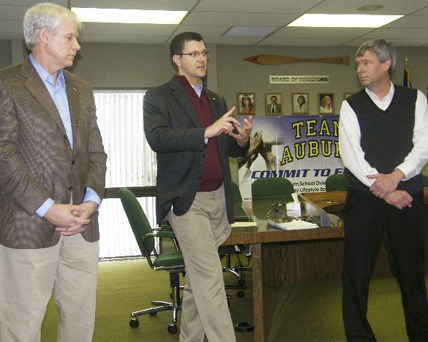She works a second job so her child can learn a foreign language and pays for after-school music lessons because her school hasn’t got any money in the budget for it.
The mother frets because her child can’t take advantage of after-school tutoring without bus service and she can’t be there to pick her up.
“I am stressed out,” the woman told State Sen. Joe Fain, and Reps. Mark Hargrove and Pat Sullivan, on their swing through the 47th Legislative District last Saturday for a chat with constituents about public education. “I am at my wit’s end. I am at my financial end. How many more jobs am I going to have to have to get to get my child the education that I think they deserve?”
Unfortunately, with the state staring at a $5 billion budget shortfall and a dire need to trim, legislators could offer little in the way of good news. The cuts will affect K-12 education and all sectors of government, and there is no way around it.
“K-12 has sustained the fewest reductions of any other sector, but they’re real,” Sullivan said. “I am going to fight as hard as I can say so they don’t get worse. But it will be a struggle.”
Hargrove noted there is no longer an official art program at Horizon Elementary in Kent. A parent stepped in after the program was cut, he said, and now runs art as an after-school program.
“Maybe we’re going to have to do that kind of thing,” Hargrove said. “And maybe that’s the way school music programs will happen, too.”
Chuck Hurt, a teacher in the Tukwila School District and father of a preschooler, took issue with that.
“Hearing you say that it’s kind of the new reality we have to accept that, as far as art programs and music programs, parents are going to step in, and these are going to be after-school programs, that doesn’t really sit well with me,” Hurt said … “I can’t accept that we are going to give those programs away … I recognize that there are going to have to be cuts and concessions, but what do you feel is the most important thing to protect?”
Fight for dollars
Fain noted the many competing needs for the shrinking education dollar.
“The big ticket items in education are K-4 enhancement dollars, employee cost-of-living increases … all-day pay, re-factoring the way we calculate depreciation on buses and many more decision points,” Fain said. “I happen to think that class size is important to retain at a lower level. K-4 enhancements have been very successful. I think you hurt the quality of education if you increase class sizes in those rooms. I really want to know where you guys are on those.”
Brooke Valentine, a mother with children in the Kent School District, asked the trio about federal mandates for which the fed has cut funding without freeing districts of their obligations to pay for them. Is there no way for districts to get out from under, she asked?
“I know you’ve made cuts to education that I don’t like,” said Valentine. “But in making those cuts, have you thought about loosening rules that school districts have to abide by, to save money?”
Fain said that getting districts out from under unfunded mandates is a “conversation happening all the time,” in Olympia. Bills are working their way through the state House and Senate now, purporting to provide flexibility to the districts’ revenue streams, he said.
Hargrove suggested greater local control over education.
“You guys, the parents and teachers, can make the best decisions, and that makes people upstairs nervous,” Hargrove said. “One problem is that on that list for unfunded mandates is (physical education). People say, ‘We’ve got to allow maximum freedom, but you’ve got to keep PE!’ We run into resistance.”
One woman noted that Washington has the third most crowded class size in Washington.
“What are we doing wrong, and what are your plans to fix it?” she asked.
“It goes back to the Basic-Ed Funding Task Force, and the work we put into that and the way we need to go about making strategic investments,” Sullivan said. “We made more than a billion dollars in investments in K-12 education when the economy was good, but we did it in areas that weren’t considered parts of basic ed and could be eliminated as soon as the economy went downward.
“The way we address it,” Sullivan added, “is by putting money into basic education so that it can’t be touched when you have the economic downtown. I think that’s the solution.”
Katherine Ulrich, 8, had one last question for the legislators.
“Can’t they make reading time longer?” said the second-grader. “I like the big books best.”
“Then I’ve got a budget for you to read,” Fain said.


